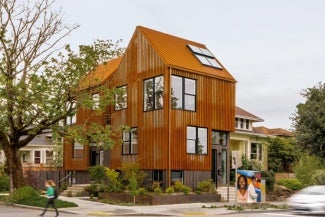
Growing the missing middle in Seattle
The city's innovative Oak & Alder development can serve as a model for other firms looking to increase housing density.
Seattle’s Central District is where architect Robert Humble, founding partner and design principal of Hybrid, calls home. About a mile from the interdisciplinary firm’s offices, the historically African American neighborhood—today reflecting the city’s housing crisis with issues of gentrification, affordability, and displacement—is also where the majority of Hybrid’s development projects are located. “Most of the development work that we do in Seattle comes through relationships that we’ve developed over the last 20 years of just getting to know our community and getting to know our neighbors,” Humble says.
It was through a relationship with a local brewer that one of Hybrid’s latest projects came to fruition. The Oak & Alder, a high-density, urban infill housing project, began inside the walls of Humble’s neighborhood bar. The owner, who had recently purchased a new house, was looking to sell his existing house on a large single-family lot and saw potential in an undeveloped side yard.
“We took what was an existing house on a 5,000-square-foot lot and subdivided [the lot] to create two 2,500-square-foot lots,” Humble explains. “We took one of those 2,500-square-foot lots and created two primary housing units,” as well as a rental option.
At a prominent intersection where a large oak tree sits in front of the project on East Alder Street, the multifamily structure designed, developed, and built by Hybrid offers a “missing middle” solution to the city’s housing crisis.
“The Oak & Alder meets the textbook definition of ‘missing middle’ in that it is in a very dense walkable neighborhood in close proximity to amenities and transit, and it directly relates to the scale and context of neighboring single-family homes,” says Alex Herbig, Hybrid’s project designer and development manager. “Despite its outward continuity with the neighboring single-family houses, the project is three times more dense than its neighbors.”
Completed in the spring, the Oak & Alder residences comprise a 1,270-square-foot unit and a 1,540-square-foot unit. The larger of the two has a ground floor “flex space” with its own entrance and a kitchenette. The two are connected by a central gasket topped by a deck, and share three parking spaces with the existing house. Both units are filled with light from large windows and feature a reverse floor plan that allows the upper-level living spaces, including lofted solarium spaces in the roof pitches, to benefit from the most light. “We did not have to tear down any buildings and displace anyone to build the project,” Humble says. Reflecting the appearance of the brick used at a nearby high school, the units are clad in rusted corten steel. Their pitched roofs, shifted 90 degrees, echo the roof forms of the residences on both streets. Elevated stoops on the front steps of both emulate those of the surrounding Craftsman homes. “What we focus on is context,” Humble says.
A family of four from Denmark occupies the slightly smaller back unit—purchased presale, sight unseen. Although the ground floor was permitted as flex space, the family chose to create two additional bedrooms for the children. A tech professional lives in the front corner unit. He rents out the ground floor unit to a longtime friend.
“These 1,500- to 1,400-square-foot townhouses nowadays are selling for close to a million dollars and we understand that is not by any means affordable, even for dual income [and] no kids,” Humble says. “We can’t really address the price of the housing market, but we can [address affordability] through the design.”
Designing flex spaces that can be used as accessory dwelling units is one move Hybrid has incorporated into several of its infill projects through the years. “We’ve seen [homeowners] use these flex spaces as an Airbnb,” for example, Humble says. “In the summer, they can pay 100% of their mortgage through Airbnb rental income. In the winter, they might pay half of it.”
At a neighbor’s house two doors down from Humble’s home, one of Hybrid’s latest projects (currently under construction) will transform what was one house on a double lot to a single-family house with a flex space, two attached townhomes, and a detached ADU. “Once again, there was one house on this lot, and now we’ve created four primary structures plus one rental opportunity,” Humble says.
Hybrid’s unique collaborative approach to development helps with the housing crisis by increasing density and avoiding displacement, as is the case with Humble’s neighbor, who has lived in the same spot for 30 years. “[My neighbor is] going to use the money from the equity of her existing land plus the money she’s going to make as a developer and buy one of the new units in the project,” Humble says.
The former property owner where the Oak & Alder now sits was able to increase his property value. “He was able to make more money selling his house and a lot as two separate transactions than he would from just selling the house with a big yard,” Humble says.
For Hybrid, co-development allows the firm to avoid the hassle of looking for land on the open market and helps improve its local community through density that does not sacrifice good design.
“I think that’s a big reason why we want to be developers and work with the community,” Humble says. “We’ll create our own vision [for] ways we can address issues of density and displacement instead of sitting around and waiting for the phone to ring for someone to ask us to do a project we’re inspired by. We’ll do our own inspiring project and learn from it, and then do another one.”
This article was originally published in ARCHITECT magazine in October 2022.
